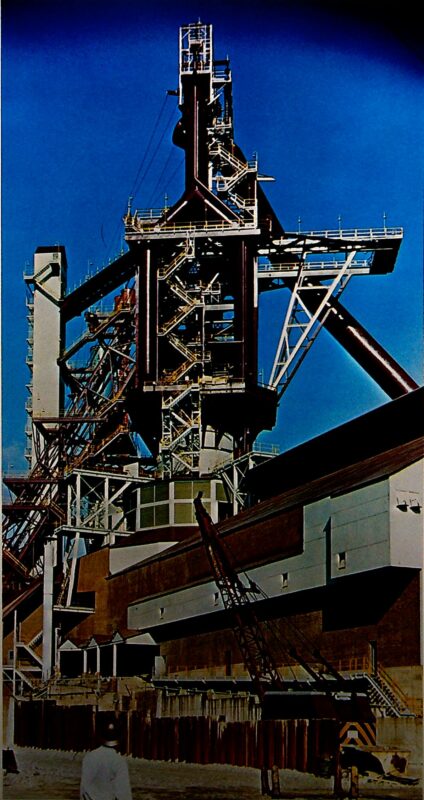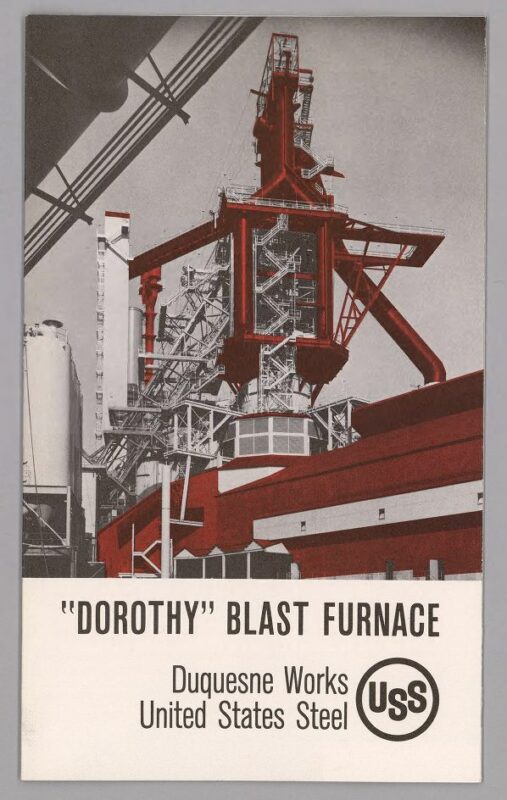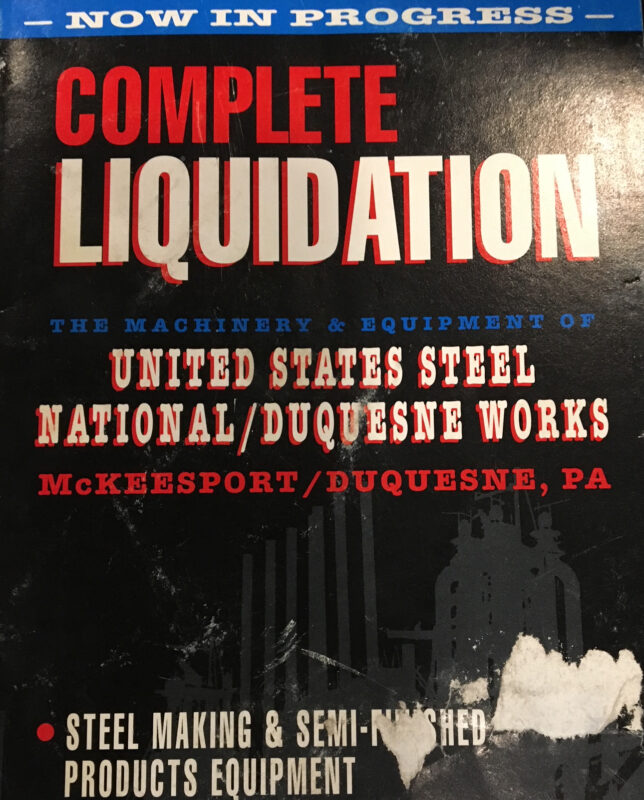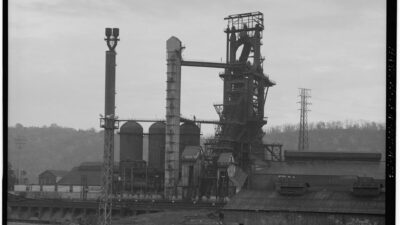More than a generation ago, an entire community fought to save a single blast furnace in the Mon Valley. After U.S. Steel decided to shut down Dorothy Six, the Duquesne Works of U.S. Steel was doomed, and nearly four decades later a community still struggles to find a path to rebuild prosperity.
Just before noon on Aug. 1, 1988, a small group of onlookers stood along a busy expressway to watch the final moments of a mostly forgotten symbol of America’s manufacturing decline. Scheduled for demolition was yet another blast furnace the steel industry had once clustered along the banks of the Monongahela River, barely 12 miles upriver from Downtown Pittsburgh.

The river and the communities of the Mon Valley had formed the core of the American steel industry for more than a century. Just a little more than a mile downriver from where they stood, Andrew Carnegie redefined the steel industry in the 1870s when the Edgar Thomson Works began operation at Braddock. A mile further downriver stood the former Homestead Works, which Carnegie acquired in 1883 and quickly integrated into his growing business.
Demolition scheduled for the morning was technically on real estate still part of U.S. Steel’s Duquesne Works, though the nominal owner had effectively abandoned the site years earlier. Four years earlier, “Taps” played over the plant’s public address system as workers finished the final shift to operate the plant’s primary blast furnace, known universally as Dorothy Six. Secondary parts of the plant continued to operate for a few more months, but Dorothy would never restart. Timing, or fate, took from Dorothy Six its last chance to avoid destruction and survive even as an artifact. A group of museum officials and preservation experts had toured the Duquesne Works just a week earlier. The team was evaluating the many shuttered industrial sites in the Mon Valley to see which could be preserved as museum pieces. But the corporation paid no heed to the work of the preservationists. Controlled explosions felled the massive industrial artifact before the group’s final report was submitted, and by noon, there was nothing recognizable left to save.
Dorothy was the crown jewel of Mon Valley when it began steel production in 1963. When first blown, Dorothy Six was not only the largest blast furnace in the world; it was the first Basic Oxygen Process (BOP) furnace to be built by U.S. Steel. American steel producers had been slow to adopt the BOP technology that began revolutionizing steel production worldwide in the 1950s.
Dorothy became more than a nickname but is remembered as a symbol of a community’s fight against economic forces far beyond their control. The moniker came from Dorothy Helen Rice Worthington, wife of U.S. Steel president Leslie Worthington, who christened the furnace in January 1963. But Dorothy Six’s larger place in history came decades later. That Dorothy Six was still standing in 1988 was a testament to the tenacity of a community that fought a historic rearguard battle to save the blast furnace from destruction.
Dorothy and the Duquesne Works had far more than symbolic importance for the future of the Mon Valley. Dorothy Six was for decades the region’s most advanced blast furnace, and the Duquesne Works was an essential link for a much more extensive network of steel production. Output from the Duquesne Works supplied steel ingots to the neighboring Homestead Works, which milled the raw steel into finished products. The plant was one of the primary users of industrial coke produced at the nearby Clairton Works. Output from the Homestead Works provided feedstock to a wide network of steel fabrication businesses across southwestern Pennsylvania. It was as mature an agglomeration of steel production as existed anywhere in the world, but without Dorothy Six, the region’s industrial ecosystem was at risk.

Rumors of U.S. Steel’s plan to close the Duquesne Works began circulating in September 1983. By early December, workers at U.S. Steel plants in Alabama, Ohio, and Illinois received letters demanding wage concessions in ongoing contract negotiations; the company threatened to shut down the plants if workers did not comply. Despite the fact that workers at Duquesne accepted significant wage cutbacks earlier in the year, U.S. Steel announced on Dec. 28, 1983, that most operations at Duquesne would end.
As with previous shutdowns, expectations persisted that once economic conditions turned around, the plant would restart. Those hopes were quashed in October 1984 when U.S. Steel announced that the demolition of Dorothy Six was scheduled to take place before the end of the year.
Workers had begun taking matters into their own hands. Local 1256 of the United Steelworkers of America approached U.S. Steel in October 1983 with a proposal to transfer the assets at Duquesne to form an Employee Stock Ownership Plan. They received no reply from corporate leaders who opposed any effort to sell the Duquesne Works to workers, or to any third party.
To keep alive any hope that Dorothy could ever be restarted in the future, the blast furnace had to be prevented from depreciating past the point of no return. Without ongoing maintenance, the furnace would not remain viable through the rapidly approaching winter. Workers volunteered to winterize the plant without pay, but U.S. Steel offered no assistance. The corporation would not pay for $4,000 in basic materials needed, even insisting workers themselves provide $16,000 to cover insurance costs before anyone was allowed to re-enter the site.
Workers then organized an unprecedented effort to protect the plant’s capital assets — not from potential theft or destruction, but from U.S. Steel itself. Workers set up a guard shanty across the street from the main gate of the mill. For more than six months, rotating shifts of unemployed steelworkers stood watch continuously to ensure the company removed no vital equipment.
Workers’ first victory came on Nov. 18, 1984, when political pressure forced U.S. Steel to postpone the demolition until February. The short reprieve allowed for a union-sponsored report to be completed evaluating the feasibility of a worker takeover of the plant. At the same time, the “Save Dorothy” campaign was becoming a national crusade. In January 1985, political activist and minister Jesse Jackson, who ran for the Democratic nomination for president in 1984 and 1988, led a protest outside the gates of the shuttered plant. He described the decision to close the plant as an “industrial mugging.”
Whatever transformation has emerged elsewhere in southwestern Pennsylvania, Duquesne has yet to arrest its economic and demographic decline. The city’s only grocery store closed in 2020 and a local poverty rate of nearly 40% remains one of the highest in Pennsylvania.
Prepared by Locker-Albrecht Associates, a union-affiliated consulting firm based in New York City, the rapidly completed feasibility report was released on Jan. 29, 1985, just days before the already-rescheduled demolition was expected to take place. The report concluded workers could operate the hot end of the plant and keep Dorothy alive, but the report did nothing to convince U.S. Steel of the plant’s viability. Even though the company reported an annual profit of $483 million the same day, the corporation made clear it was not planning to reinvest at Duquesne nor aid in transferring the plant to employees. Nonetheless, the optimistic conclusion of the Locker-Albrecht report forced U.S. Steel to delay the demolition of Dorothy Six for a second time.
What had become clear was that if Dorothy Six was ever to restart, it would have to be under a new owner. Without any potential buyers, alternate means were needed to take direct ownership of the site, with or without cooperation from U.S. Steel. But how could the community wrest control of the plant away from the corporation?
Local labor and community leaders had formed a partnership with a coalition that had emerged in Youngstown, Ohio, where there were concentrated job losses following Black Monday, Sept. 19, 1977, when the abrupt closure of the Campbell Works forced 5,000 workers out of their jobs. The Tri-State Conference on Manufacturing was founded in 1979, in part by Pittsburgh lawyer Staughton Lynd, and proposed a revolutionary tactic to combat escalating deindustrialization. If corporations were unwilling to keep plants running, workers would take control and operate the businesses. The vision had not found success in Ohio, but by the early 1980s, industrial job losses were expanding, and Tri-State had expanded its campaign into Pennsylvania.
Pennsylvania law seemed to give Tri-State the tool it needed to wrest control of industrial capital from corporations. Section 306 of the Municipal Authorities Act of 1945 allowed municipalities in Pennsylvania to establish public authorities focused on economic development. Such authorities had the right to exercise eminent domain, which was commonly used to acquire real estate, a power that had been used widely during Pittsburgh’s Renaissance to acquire land Downtown for redevelopment. Tri-State wanted to turn the statute on its head and use eminent domain to take control of industrial facilities from owners trying to shut them down. In November 1985, seven municipalities in the Mon Valley, along with the City of Pittsburgh, agreed on the creation of a new redevelopment authority – the Steel Valley Authority (SVA) – to be charged specifically with fighting deindustrialization.
Restarting Dorothy Six was more than just a technical challenge. To be viable again, output from the Duquesne Works needed investment and a sustainable business model. Soon after Locker-Albrecht released its report, the United Steelworkers commissioned a follow-on study to produce a detailed business plan for a reopened Duquesne Works that might attract investors. Wall Street investment consultant Lazard Frères and the local investment firm of Russell, Rea and Zappala agreed to complete the study pro bono.

The report did not provide the path that so many wanted. Released in January 1986, the report concluded that “reopening Dorothy Six was not financially feasible.” Recognizing the ongoing battle to restart the blast furnace, the consultants were apologetic: “The people who worked so long and so hard to save Duquesne did not give up on Duquesne and will not give up on the steel industry.” The Lazard Frères report closed off the possibility of attracting the necessary capital needed to restart Dorothy. On Jan. 9, 1986, U.S. Steel and the USW issued a joint press release announcing the end of efforts to restart any part of the Duquesne Works.
How did Lazard Frères come to such a different conclusion? Locker-Albrecht had not been in error so much on the technical challenges facing the Duquesne Works but on the practical reality of competing against U.S. Steel. The earlier analysis had presumed that an independent Duquesne Works could operate symbiotically with the remaining vestiges of U.S. Steel in the Mon Valley, much as it had for a century. However, it was a business model that relied on U.S. Steel’s cooperation, or at least impartial business practices. Lazard Frères discovered that not only would U.S. Steel not be a willing business partner with any employee-owned plant but it planned to be an aggressive competitor: “They told us in no uncertain terms that if the facility went they would throw everything they had at it to compete with it.”
The SVA was officially incorporated in January 1986, just as the release of the Lazard Frères study doomed efforts in Duquesne. The new authority shifted its efforts to keeping other plants in the valley operating. Its next focus was LTV’s South Side Works, just six miles downriver from Duquesne. As with Duquesne, the shuttered LTV site never reopened. The Steel Valley Authority’s only formal legal effort to exercise eminent domain came in March 1986 when it filed suit to block the American Standard Company from closing its plant in Swissvale. The SVA’s petition was rejected by a federal district court based on a technicality that the property had never been formally condemned, a requirement in the Pennsylvania law for the use of eminent domain.
Envisioning a future without steel remained nearly impossible for the communities of the Mon Valley. In 1988, two years after the Save Dorothy Campaign had failed, the American Institute of Architects sponsored its first Remaking Cities Conference. The international conference of architects and planners included a joint team of British and American planners that came to the Mon Valley to study the massive transformation taking place there. Team member Tony McGann — who had worked on transforming former industrial communities in the United Kingdom — reacted to residents’ persistent goal of reopening steel plants: “You’ve got to face reality. They’re gone,” he said at a public forum. “We decided to do something about it, and you can, too. If you wait for the steel industry to come back, you’ll wait forever.”

Over the subsequent quarter-century, no industry replaced any more than a fraction of the jobs lost from the closure of the Duquesne Works. The consequences extended far beyond lost jobs, however. Shortly before the plant was closed, half of the municipal budget for the City of Duquesne was generated by the plant. When the plant first closed, USX Corporation — as U.S. Steel was renamed after merging with Marathon Oil and moving its headquarters to Texas — promised to continue property tax payments to the City of Duquesne and its coterminous school district for 17 years. When those payments ended in 2001, no substitute ever made up more than a fraction of the lost revenue, putting further strain on already dire municipal and school district finances. By 2009, the Duquesne School district was forced to shut down its high school. Local students were sent to neighboring school districts that were forced to take them pursuant to an order from the Pennsylvania Department of Education.
The brownfield site of the former Duquesne Works remained a focus of redevelopment efforts for decades, but the number of jobs created on the site never made up even a fraction of the number of jobs lost at the Duquesne Works. The most notable new tenant has been a textile and mattress factory that moved its operations to Duquesne in 2003. Even those jobs did not reflect new growth for the Pittsburgh region. The firm had relocated its operations from the city of Pittsburgh’s Lawrenceville neighborhood.
Whatever transformation has emerged elsewhere in southwestern Pennsylvania, Duquesne has yet to arrest its economic and demographic decline. The city’s only grocery store closed in 2020 and a local poverty rate of nearly 40% remains one of the highest in Pennsylvania.
Once home to more than 21,000 people, by 2020 Duquesne’s population had dropped to just 5,534 residents. The Duquesne School District still lacks a high school. Local 1256, the Duquesne branch of the United Steelworkers, found itself without active members once the Duquesne Works shut down. The local’s union hall was converted into a personal care home in 1987 and today is used as a daycare business. Less than two weeks after Dorothy Six was felled, the Allegheny County Department of Economic Development announced that the demolition was expected to produce between 175,000 and 200,000pounds of scrap steel.
So valuable was the industrial residue that its $22 million value exceeded the $14 million cost of the demolition itself. To the accountants, at least, the public was coming out ahead.







